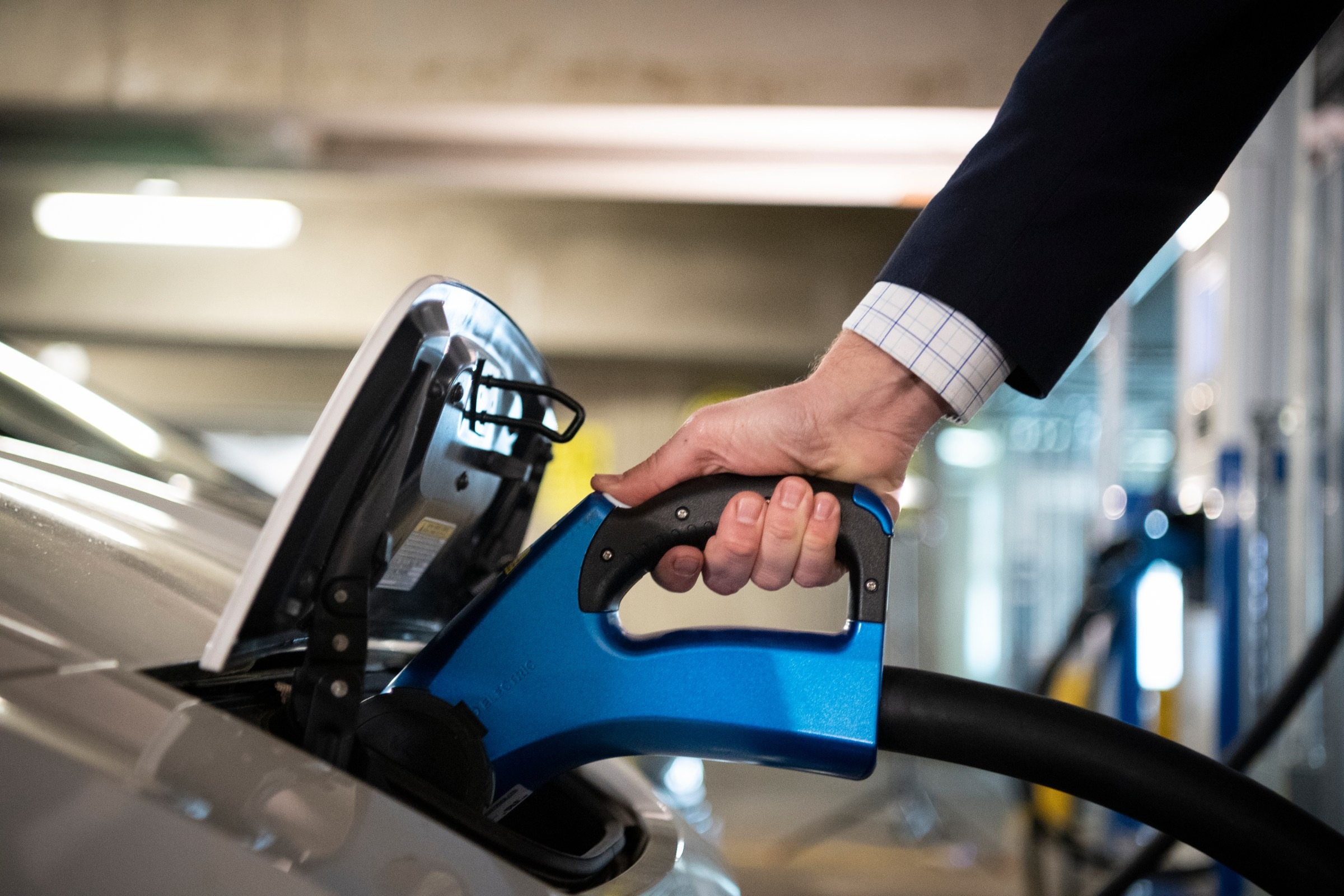Electric vehicles have steadily grown in popularity across the United States, and this change has brought a fresh emphasis on charging infrastructure. As more individuals make the switch to battery-powered transport, the presence and accessibility of public charging points become even more important.
It is no longer just about having a car that reduces petrol consumption. Now, convenience and practicality of recharging are just as important as performance and design.
With petrol stations across highways and city centres, drivers have always known where to refuel. Now, the discussion is turning towards how electric car users can recharge with similar ease.

Public charging stations are popping up where gas pumps used to reign (Photo: Twitter)
From home installations to high-speed public stations, options are increasing by the day. Yet, many consumers are still unsure about how EV charging works, what types are available, and what to expect as electric mobility expands.
Let us now look into the essentials that every current or prospective EV driver should understand. This includes the various types of charging stations, how long they take, how much they cost, and how things may develop in the coming years.
Categories of Charging Stations
Electric vehicle charging options fall into three primary groups based on the speed and power level of the electricity they deliver. Each category serves a different purpose and suits different driving routines.
Level 1 charging makes use of a standard residential power outlet, usually at 120 volts. It is the slowest of the three types and is mostly practical for drivers who do not cover long distances daily.
With this method, cars can gain roughly three to five miles of range for every hour they remain plugged in. This method is often the default for those who charge their vehicles overnight at home without special equipment.
Level 2 charging moves faster and requires a 240-volt outlet, like the ones used by large household appliances such as dryers. This setup is common in public parking areas, commercial spaces, and private homes with a dedicated charging unit installed.
Drivers can typically expect between 10 and 60 miles of range per hour of charging, depending on the model of the car and the power rating of the charger. Level 2 units have become widely available in urban and suburban locations.
Level 3 charging, also referred to as DC fast charging, delivers the quickest charging times. These stations convert alternating current to direct current and operate at much higher voltages.
Drivers can top up their batteries in under an hour in many cases, sometimes reaching 80 percent charge in less than 30 minutes. This type of charging is commonly found along highways or major travel routes, making them ideal for longer trips.
Charging Station Locations and Availability
The rise of electric cars has encouraged businesses and government bodies to make EV charging points easier to access. Urban centres, shopping malls, office parks, and hotels are just a few examples of places where Level 2 charging units have become more frequent. Many retailers have installed these chargers to attract customers who want to top up while shopping or attending appointments.
High-speed charging stations have been built along major roads to ensure that long-distance travel is possible without extended delays. These charging points are usually found near rest stops or service areas, where drivers can take a break while their vehicle receives a power boost.
Home charging remains the most convenient option for many electric car owners. With the right equipment installed, drivers can plug in overnight and start each day with a full battery. The costs of installing home charging stations vary, depending on the wiring in the home and the specific charging equipment selected.
Charging Duration and Speed
The amount of time it takes to recharge an electric vehicle depends on several factors. The size of the battery, how much power the charging station delivers, and how low the battery was when plugged in all affect the result. Larger vehicles, such as SUVs or electric trucks, often need more time than compact sedans or hatchbacks.
Level 1 charging, while slow, suits individuals with short daily commutes who leave their car parked for extended periods. Level 2 provides a middle ground between convenience and speed, often recharging most cars within four to eight hours. Level 3 chargers are suitable for when time is limited, such as during road trips or when a quick top-up is needed before a busy day.
Some stations display the charging speed on a screen, and many modern EVs also offer real-time updates through mobile apps or dashboard interfaces. These tools help drivers estimate how long it will take to reach their desired range.
Costs Related to EV Charging
Charging an electric car can lead to savings when compared with filling a petrol tank, but the cost of electricity varies by location and charging method.
Home charging is usually more affordable, especially if the vehicle is charged during off-peak electricity hours. Public charging, particularly fast charging, often carries a higher price due to the advanced technology involved.
Many charging stations operate on a pay-per-use basis, charging per kilowatt-hour or per minute of use. Some services offer memberships that provide discounts or allow unlimited charging for a fixed monthly rate. It is important for drivers to compare options and choose what fits their habits and budget.
Charging networks often include mobile apps that show pricing in advance and even allow remote payment, reducing delays or confusion once on-site. As more providers enter the market, price competition may encourage better rates for consumers.
Importance of Charging Networks
A wide-reaching and reliable charging network is a major part of building confidence in electric cars. Drivers must be assured that charging stations are present where they need them and that the equipment will function properly when required. This is where large networks come into play, offering consistent service, dependable support, and integration with vehicle systems.

Level 1 charging may be slow but it gets the job done while you sleep (Photo: Alamy)
Some car manufacturers have created their own charging networks to complement their vehicles. These branded stations usually work best with their models, although many also allow other brands to use the service. Other providers focus on building third-party stations that serve a variety of car makes and models.
The push to build more charging stations is ongoing, and partnerships between private companies and public authorities have become central to this growth.
Federal and local governments have provided grants and incentives to assist with infrastructure development. This cooperation makes it easier for both businesses and residential communities to take part in supporting EV charging.
Technological Advancements and Future Outlook
Electric vehicle charging has improved steadily over the past few years. Chargers have become faster, more efficient, and easier to use. Smart charging has become more common, where the system adjusts power flow based on demand, cost, or environmental conditions.
There are also developments around vehicle-to-grid technology, which allows cars to send electricity back into the power grid. While this is still under testing and not widely available, it shows how EVs might take part in broader energy solutions in the future.
Another area seeing growth is wireless charging. Instead of plugging in, vehicles park over a charging pad that transfers electricity through induction. While still rare, it may become more widespread in the years ahead.
Manufacturers are working on improving battery capacity and charging speed. This means drivers will be able to travel longer distances without waiting as long for their cars to recharge. These upgrades could make electric cars more appealing to those who have hesitated so far.
Environmental and Practical Benefits
Electric vehicles produce no exhaust emissions, making them cleaner during use when compared with traditional petrol-powered cars. Charging with renewable energy further reduces their environmental impact. For cities looking to improve air quality and reduce reliance on fossil fuels, EVs offer a cleaner way forward.
Noise reduction is another benefit. Electric motors operate more quietly than combustion engines, creating less disturbance in residential and urban areas. As more EVs appear on the road, this could contribute to a calmer driving environment.
Maintenance needs are often lower with electric vehicles. Since they have fewer moving parts, owners may spend less on repairs and regular servicing. Charging at home also eliminates trips to the fuel station, saving time and effort for daily drivers.
























